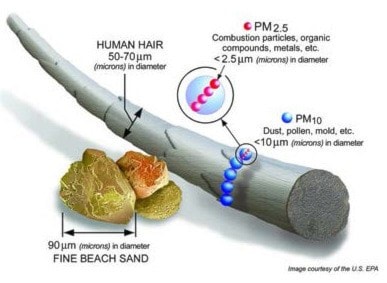Vanderhoof is found to be the fourth smokiest community in B.C. during 2015, according to the Ministry of Environment.
Partnering with air quality and public health experts from the University of British Columbia and BC Centre for Disease Control, the MOE discussed “What is in the air?” in a public forum hosted by BC Lung Association at the Nechako Senior Friendship Centre on Nov. 22.
One of 23 towns identified and monitored for their wood smoke concerns, Vanderhoof is ranked behind Houston, Courtney, and Port Alberni for the highest number of smoky days in the province last year.
The concentration of particulate matter as big as one-fifth of a human hair’s diameter (PM10) — such as road dust and pollen — as well as those that are one-quarter of PM10’s diameter in size (PM2..5) — such as combustion particles from wood burning — are measured in Vanderhoof by a monitor located on the roof of the local courthouse.
In 2015, Vanderhoof’s levels are found to exceed the provincial government’s daily and annual objectives for PM2.5, and the daily objective for PM10.
While there are no safe level of exposure to polluted air — government policies are aimed to improve air quality as much as possible — Vanderhoof is still one of the cleaner parts of the world, as well as within North America, said Michael Brauer, a UBC expert on air quality and public health.
“It’s something that chips away at our life expectancy bit by bit, like lack of exercise or bad diet,” Brauer said.
In addition to causing chronic lung diseases and strokes, air pollution has shown to also affect the brain, he added, referencing a recent study.
In Vanderhoof during fall and winter, the most significant source of polluted air is found to be residential wood burning, and road dust during spring and fall. An air advisory in the community was issued by the Ministry of Environment on Dec. 7 due to still air and poor dispersion, and was then cancelled by Dec. 9 as wind speeds increased.
Notified of the 2015 results earlier this year, the District of Vanderhoof is looking into conducting a door-to-door wood stove survey in the community.
The survey will collect data on the number of wood stoves in town, whether the wood stoves have emissions certification, wood burning habits, and general feedback on local air quality.
The information will provide a good start for Vanderhoof’s potential new wood burning bylaw, which is in discussion by the district’s environment committee, said CAO Tom Clement. For the ministry, the collected data will help staff to investigate local wood stove exchange programs, provide targeted education, and understand the distribution area of the emission source.
Scheduled for the coming late January is a mobile monitor driven around the neighbourhoods of Fraser Lake and Vanderhoof by a Master’s student studying occupational and environmental health in UBC, said Sarah Henderson, BCCDC’s senior environmental health scientist. The drive-around will allow the ministry to better understand the quality of different residential air pockets in the district; Courtney, Cumberland, Whistler, and Pemberton are the other monitored-non-monitored community pairs that will be studied further through the driving tours.
Provincial wood stove regulations were changed in November this year to reduce smoke smoke from home heating, according to the MOE. The new regulation requires almost all wood burning appliances sold in the province to be certified to meet emissions standards set by the US Environmental Protection Agency in 2015, or equivalent standards set by the Canadian Standards Association in 2010.
